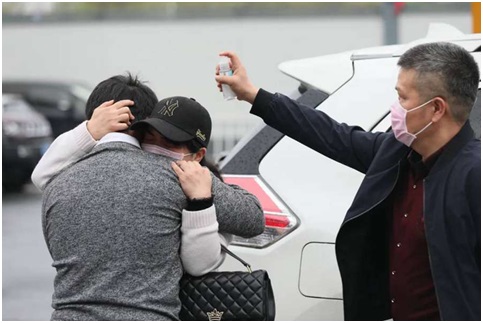By Li Aixin
Chinese experts and local citizens have shown confidence in Wuhan’s reopening since Saturday due to strict prevention and control systems launched in the city after it was put under lockdown in January.
Most of Wuhan’s subway network resumed services on Saturday with one difference – each train has a security guard who makes inspection tours, reminding people to wear face masks, avoid gatherings and scan their codes when getting off the subway.
Since Saturday, 184 subway stations on six lines have come back to service with 200 newly installed infrared intelligent temperature monitors. Passengers are asked to scan their health QR codes with real-name registration, check body temperatures before entering the stations and sit with an empty seat between every two persons. There are yellow lines on the floor reminding passengers to keep one meter away from each other when queuing.
Reports show more than 183,000 passengers took the subway on Saturday, and more than 60,000 people arrived at the three major railway stations in Wuhan from other parts of the country the same day. Restrictions on people leaving the city will be lifted on April 8.
Besides, the Wuhan Tianhe International Airport will also resume domestic flight services from April 8. Hubei’s other major airports reopened Sunday.
As the city is gradually restoring normal traffic, some observers voiced concerns over future challenges the city faces to prevent COVID-19 from breaking out again given the large-scale incoming personnel and possible carriers with no symptoms.
“I don’t think there will be a major challenge in this regard as I always believed the epidemic [in China] will end very soon,” Yang Zhanqiu, a Wuhan-based virologist, told the Global Times on Sunday, adding the current natural environment, including climate and temperatures, will make it increasingly hard for the coronavirus to survive.
He noted that patients with no symptoms are not the main spreaders of the novel coronavirus.
Medical experts believe that Wuhan’s stringent detecting system and local people’s high vigilance against the virus imply that a second large-scale outbreak will hardly be possible.
The efficiency of the city’s virus detection and relevant medical support is much higher than before, said Zhou Zijun, a professor at the Peking University School of Public Health, noting that the health QR codes, which every incoming passenger to Wuhan has, can track and act as proof of people’s health conditions.
Echoing that view, Yang pointed out “the code is like a traffic permit in almost every public setting, especially on public transportation and in supermarkets.”
Quite a few netizens from Wuhan have posted photos and videos of their food deliveries, subway trips and scenery in their neighborhoods.
Some Wuhan residents, who were previously stranded elsewhere and took the first-day trains back to the city, expressed on social media their excitement to go back home and confidence in the epidemic situation there.
“Our bustling city is back, everything will be fine,” one netizen wrote on Sina Weibo.
Source:Global Times
On March 24, Meng Shiqi, a student at the Zhongnan University of Economics and Law, hugs his mother tightly at the Wuhan railway station while his father sprays alcohol for disinfection. Before Wuhan was locked down due to the epidemic over two months ago, Meng visited a friend outside the city and was only able to return home today. (Photo by Liu Yu/People’s Daily Online)










Leave a Comment